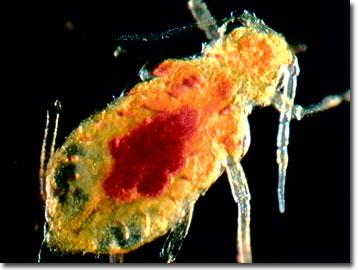Darkfield Digital Image Gallery
Aphids
Aphids, the vampires of the plant kingdom, are members of the order Hemiptera (the true bugs) in the class Insecta. As are other hemipterans, aphids are equipped with highly modified mouthparts that permit the injection of salivary juices and the siphoning off, in this case, of phloemic plant juices. Analogous to the anti-clotting substances of mosquitoes, leeches, and many endoparasites, aphid saliva contains a compound that prevents the normal healing of a plant wound until the aphid has feasted. Two tubes or cornicles, resembling the dual exhausts of an automobile, excrete a sugary waste product known as honeydew.

Known also as plant lice or ant cows, aphids create significant economic hardships for farmers, horticulturists, and home gardeners by causing leaf curling and other deformations. These insects are also responsible for sooty molds, wilting, damage to fruits and vegetables, and in some cases, they act as vectors for plant diseases. Although aphids rarely kill their plant hosts, the mouthparts are sometimes contaminated during feeding on diseased plants. When the aphid moves to the next plant host, it acts as a carrier, infecting other plants with its tainted mouthparts.
Most aphids are specific to a type of vascular plant, but some are generalists. Almost every plant species has a corresponding aphid species to which it is susceptible. Although there are commercial insecticides for killing aphids, environmentally friendly alternatives utilizing biological controls, such as living ladybugs, green lacewings, and parasitic microwasps, have created a new commercial industry. These environmentally friendly agents are ideal for integrated pest management that is particularly appealing to organic produce farmers and their customers.
Contributing Authors
Cynthia D. Kelly, Thomas J. Fellers and Michael W. Davidson - National High Magnetic Field Laboratory, 1800 East Paul Dirac Dr., The Florida State University, Tallahassee, Florida, 32310.
BACK TO THE DARKFIELD IMAGE GALLERY
BACK TO THE DIGITAL IMAGE GALLERIES
Questions or comments? Send us an email.
© 1995-2025 by Michael W. Davidson and The Florida State University. All Rights Reserved. No images, graphics, software, scripts, or applets may be reproduced or used in any manner without permission from the copyright holders. Use of this website means you agree to all of the Legal Terms and Conditions set forth by the owners.
This website is maintained by our
Graphics & Web Programming Team
in collaboration with Optical Microscopy at the
National High Magnetic Field Laboratory.
Last Modification Friday, Nov 13, 2015 at 01:19 PM
Access Count Since September 17, 2002: 12395
Visit the website of our partner in introductory microscopy education:
|
|
